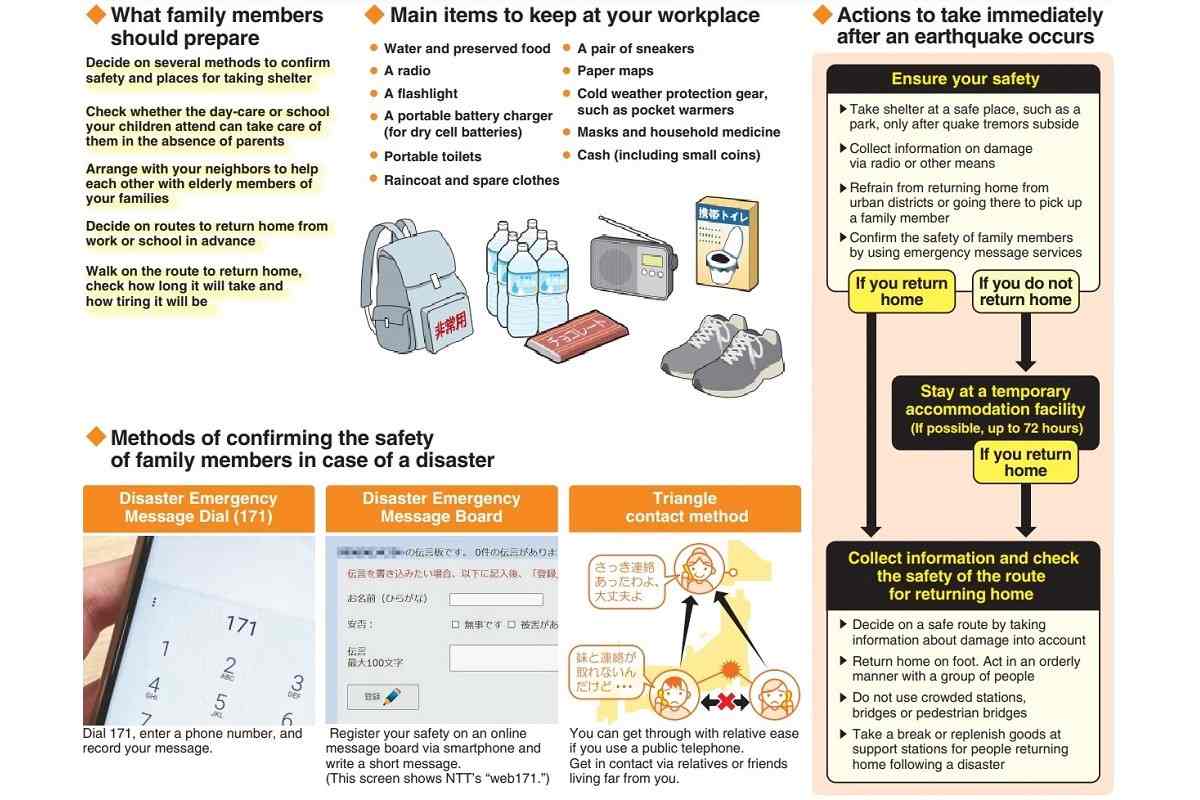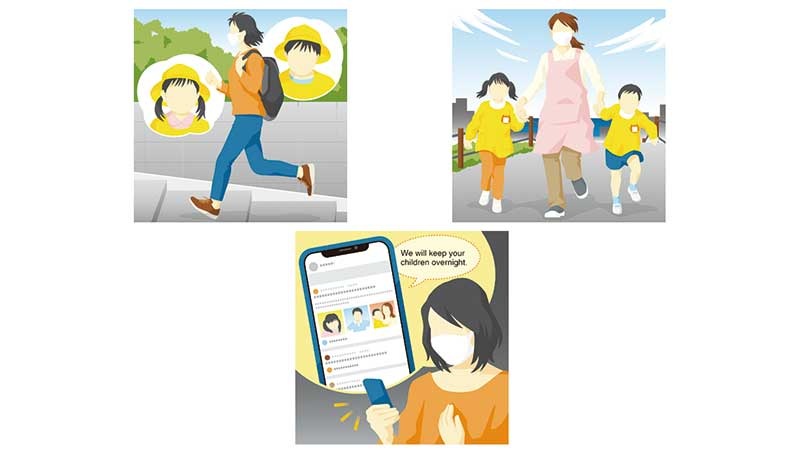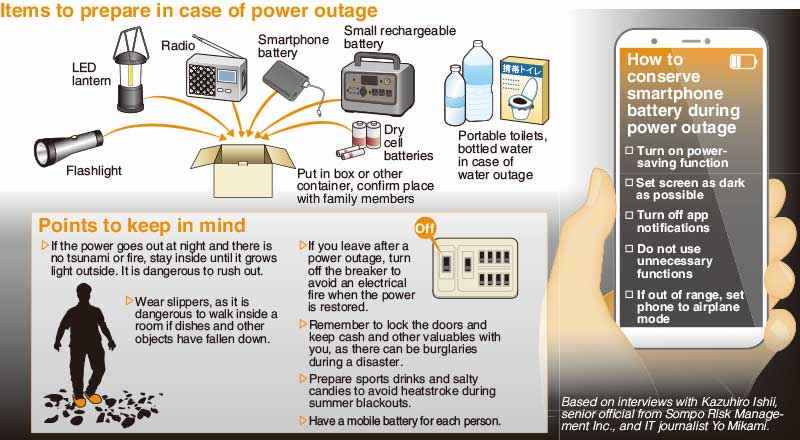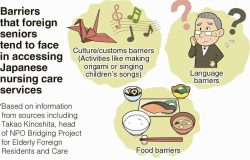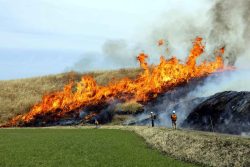Disaster Preparedness / Evacuees Struggle with Cold Temperature at Crowded Shelter; Lack of Supplies Such as Diapers Cause Anxiety

*Based on an interview with NPO Rescue Stock Yard
11:21 JST, February 19, 2024
When a major earthquake occurs in winter, there is a risk of hypothermia and economy class syndrome due to the cold and lack of physical activity in an evacuation center. In the aftermath of the Noto Peninsula Earthquake, there are concerns that power and water outages as well as supply shortages can lead to the deterioration of evacuees’ health. This special feature will discuss how to prepare for life in an evacuation center in fictitious scenarios.
***
Scenario 1: First floor of a house collapses
Taro, 35, who works as a farmer in a suburb in the Chubu region, lives with his father Kazuo, 70, his wife Hanako, 28, and their 6-month-old son Ichiro in a 50-year-old two-story wooden house. One evening during a winter holiday, in the living room on the first floor, the family were taking care of a happy Ichiro in a baby bed.
Suddenly, they were hit by a huge tremor unlike anything they had experienced before. The house shook violently from side to side, and there was a creaking sound.
“It’s not safe to stay here. Let’s get out,” Taro screamed. He put Kazuo, who had a bad leg, on his back. Hanako quickly grabbed Ichiro, who had started crying. They only just managed to get out through the front door.
The ground was so shaky, making it very difficult to stand. When Taro looked back, he saw that the first floor of their house had collapsed and was flattened. The shaking continued for several minutes. “What if we had escaped a little later,” thought Taro, who could do nothing but stand feeling dazed.
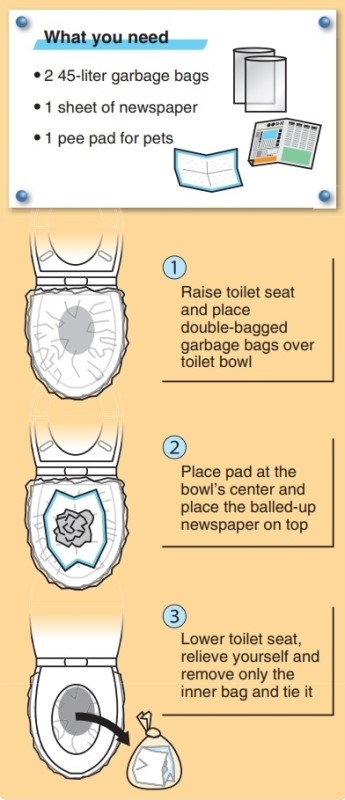
How to craft a makeshift toilet
*Based on an interview with Naomi Tsuji
Scenario 2: Walking to an elementary school
Roads around the area had been raised, with collapsed houses blocking some of the routes. “Let’s go to an evacuation center,” Hanako proposed. The designated evacuation center was an elementary school gym located several kilometers away, but it was not accessible by car. It took about an hour to get there on foot.
The evacuation center was overflowing with people. As water and power outages continued, the temperature significantly dropped at night and the floor felt quite cold. Kazuo was shivering as they did not have enough warm clothes. “I hope we won’t get hypothermia,” Hanako sighed. Blankets, heaters and mats were in short supply at the shelter.
Scenario 3: ‘No diapers or milk’
Ichiro kept crying and Hanako was in a panic as they didn’t have diapers or milk. Kazuo didn’t have time to take his medicine for a chronic disease, and was worried that infectious diseases could spread in the cramped evacuation center. Taro went to a nearby drugstore and found a long line of people. Diapers, milk and other supplies had sold out. He realized that he should have prepared an emergency bag.
Meanwhile, Hanako was able to get milk and other items from another family, who told her that they had plenty of supplies. She was relieved when the distribution of supplies began. However, the temporary toilets were located outside and it was freezing cold. Amid increasing anxiety, the family wondered how long they would have to live in the evacuation shelter.
Avoid hypothermia, infectious diseases, economy class syndrome
While in evacuation centers during winter, special care should be paid to prevent hypothermia, infectious diseases and economy class syndrome.
Hypothermia
Hypothermia is a possibly fatal condition in which the body’s core temperature falls below 35 C, making it impossible to maintain normal body functions.
The Society for Disaster Shelter and Refuge Life said warm clothes, layered clothing and huddling together are effective ways to stay warm. The society also said if you experience symptoms such as quivering uncontrollably or being slow to respond, then you need to go to the hospital.
“Simply spreading a blue sheet on the floor is not enough to survive the night in cold climates,” the society’s executive director Masahiro Nemoto, an expert on cold-weather evacuation, said. “You must keep your body off the floor.”
According to Nagoya-based nonprofit organization Rescue Stock Yard, placing corrugated cardboard or newspapers on the floor will help alleviate the cold. Plastic bags can also be used to insulate windows and it is also good to close the curtains.
In addition to layering clothing, it helpful to wrap newspaper or bubble wrap around your body or layering them between clothes as it will reduce heat loss. If blankets or thermal sheets are on hand, wrap them around the entire body and tie around your waist with string.
“Use anything close at hand,” the NPO’s spokesperson said.
Infectious diseases
Winter is also the season for infectious diseases such as influenza to spread. Wearing masks, washing hands and ventilating rooms frequently are important.
The Health, Labor and Welfare Ministry recommends opening doors and windows in spaces with poor ventilation or that are crowded with people. It is effective to open two doors or windows located diagonally from each other.
Tokyo Healthcare University Prof. Erisa Sugawara recommends wiping your hands with a wet towel if there is no running water.
Food poisoning caused by norovirus occurs often in winter, too. Washing hands after using the bathroom and when cooking, as well as disinfecting cooking utensils can help prevent infection.
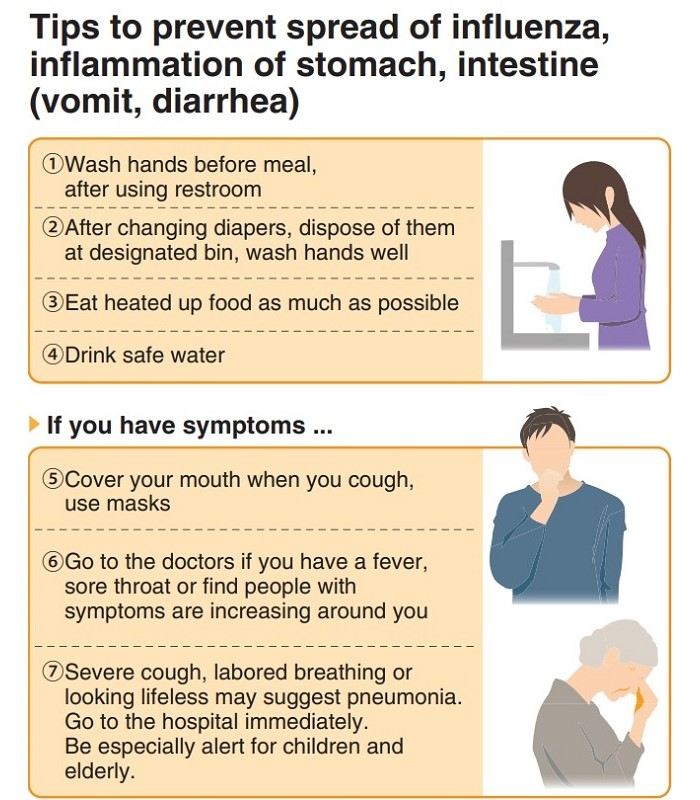
Economy class syndrome
When it is cold, people tend to drink less water to hold off needing to use the restroom, resulting in people becoming ill. Meanwhile, being in the same posture for a long time can increase the risk of economy class syndrome, a disease in which blood clots formed in the legs become lodged in blood vessels in the lungs. The Japanese Society of Phlebology and other groups recommend massaging the calves or lifting and lowering your toes.
In some cases, lack of running water may keep you from using the restroom. Rescue nurse Naomi Tsuji introduces a way to create makeshift toilets with 45-liter garbage bags, newspaper and a pee pad for pets. Additional pieces of newspapers or waste cloths can be used as substitute for pee pads, she said.
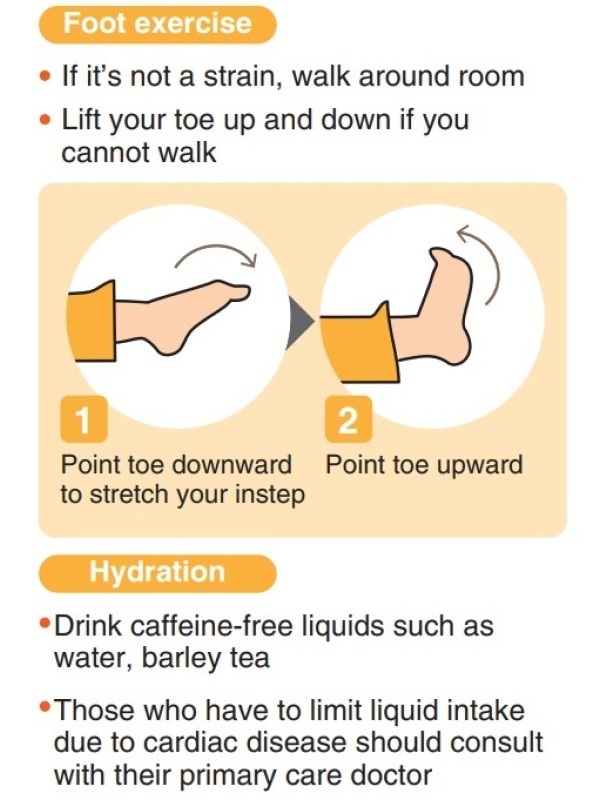
*Based on documents provided by Japanese Society of Phlebology
Health care is particularly important for infants and elderly people
When staying at a disaster shelter, special attention should be paid to the health care and food of infants and elderly people. Preparation during daily life is also important.
As a baby’s body temperature is sensitive to air temperature, they should be wrapped in blankets or warm sheets and held at the shelter, if there during the cold winter.
If water is not readily available due to a lack of running water, it would be advisable to give infants formula milk from disposable paper cups. Any leftover milk should be discarded.
Oral care should also be provided. In many cases, relief supplies include food such as sweet buns, and infants and children are more likely to develop cavities. If teeth wipes or a similar item is at hand, one should use it.
Mayu Kamon, a disaster relief specialist, says, “Evacuation shelters may not have enough emergency stocks for infants, so it is best to prepare during daily life by imagining what evacuation life would be like.”
In disaster-stricken areas, diapers may run out. The Saitama prefectural branch of the Japanese Red Cross Society has introduced a simple method for making a diaper for infants, by using a plastic shopping bag and a towel. Using a 45-liter garbage bag will make a diaper for an elderly person, too. Since these diapers are made simply, it is necessary to check them often to make sure there is no leaking.
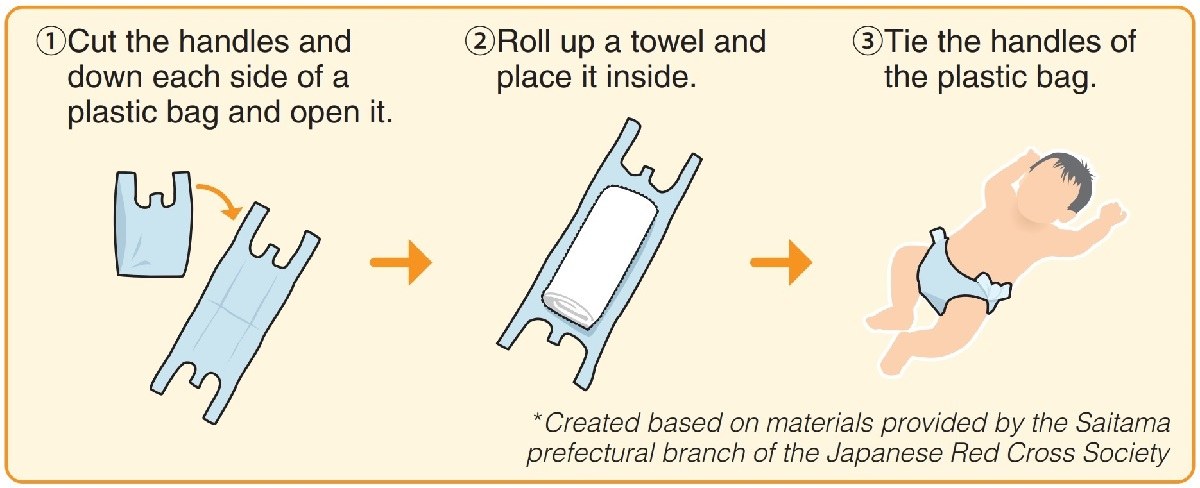
Elderly people are more likely to have their condition worsen, and there is a risk of disaster-related death. Itsuki Nakabayashi, professor emeritus of Tokyo Metropolitan University and a scholar on urban disaster prevention, advises, “The worst thing for [elderly people] is to not move around or eat anything. They had better keep their body moving by, for instance, cleaning a disaster shelter and helping with its operations. If they talk to other people, they will feel less depressed.”
Frail elderly people may develop aspiration pneumonia if their mouths are unsanitary. So special attention should be given to their oral care.
Also, elderly people may sometimes have their physical condition deteriorate before they realize it, and become seriously ill before those around them notice. If they become friendly with other evacuees at the shelter and support each other by checking in to see if they are doing fine or not, changes in health are more likely to be spotted.
Since many elderly people take medication for chronic illnesses, it is important for them or their children living elsewhere to keep a copy of their drug prescription record. By doing so, even if they could not take their medication with them when taking shelter, they may be able to obtain it by informing the DMAT (Disaster Medical Assistance Team) or others of the name and dosage.
"JN Specialities" POPULAR ARTICLE
-

The Japan News / Weekly Edition (12/12-12/18)
-

English-language Kabuki, Kyogen Entertain Audiences in Tokyo; Portland State University Professor Emeritus, Graduates Perform
-

Noodle Dining Shunsai / Rich Oyster Ramen to Savor at Odasaga; Experienced 68-year-old Owner Creates Numerous Ramen Varieties
-

The Japan News / Weekly Edition (12/5-12/11)
-

People Keep Loved Ones’ Ashes Close in Special Jewelry, Small Urns as Unique Way to Memorialize Them
JN ACCESS RANKING
-

Keidanren Chairman Yoshinobu Tsutsui Visits Kashiwazaki-Kariwa Nuclear Power Plant; Inspects New Emergency Safety System
-

Imports of Rare Earths from China Facing Delays, May Be Caused by Deterioration of Japan-China Relations
-

University of Tokyo Professor Discusses Japanese Economic Security in Interview Ahead of Forum
-

Japan Pulls out of Vietnam Nuclear Project, Complicating Hanoi’s Power Plans
-

Govt Aims to Expand NISA Program Lineup, Abolish Age Restriction
